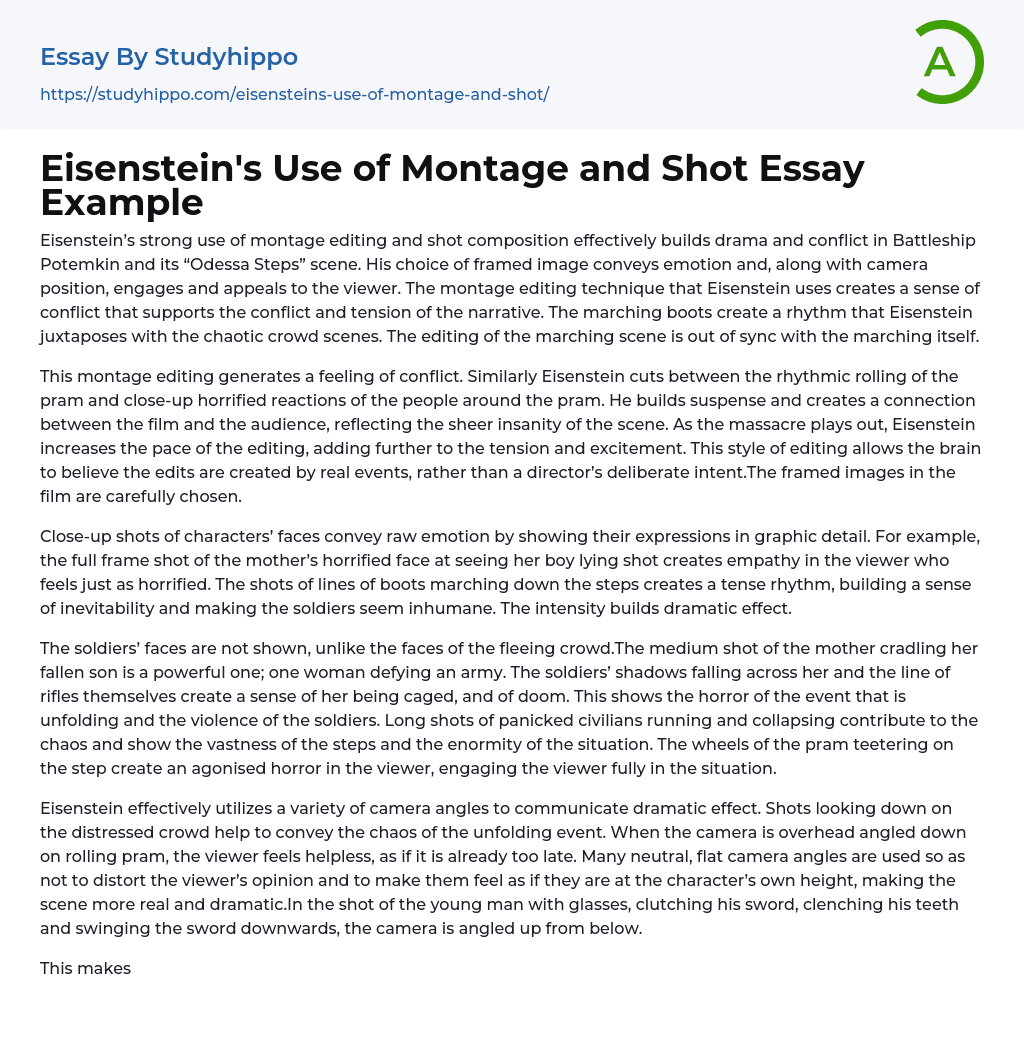Eisenstein’s strong use of montage editing and shot composition effectively builds drama and conflict in Battleship Potemkin and its “Odessa Steps” scene. His choice of framed image conveys emotion and, along with camera position, engages and appeals to the viewer. The montage editing technique that Eisenstein uses creates a sense of conflict that supports the conflict and tension of the narrative. The marching boots create a rhythm that Eisenstein juxtaposes with the chaotic crowd scenes. The editing of the marching scene is out of sync with the marching itself.
This montage editing generates a feeling of conflict. Similarly Eisenstein cuts between the rhythmic rolling of the pram and close-up horrified reactions of the people around the pram. He builds suspense and creates a connection between the film and the audience, reflecting the sheer insanity o
...f the scene. As the massacre plays out, Eisenstein increases the pace of the editing, adding further to the tension and excitement. This style of editing allows the brain to believe the edits are created by real events, rather than a director’s deliberate intent.The framed images in the film are carefully chosen.
Close-up shots of characters’ faces convey raw emotion by showing their expressions in graphic detail. For example, the full frame shot of the mother’s horrified face at seeing her boy lying shot creates empathy in the viewer who feels just as horrified. The shots of lines of boots marching down the steps creates a tense rhythm, building a sense of inevitability and making the soldiers seem inhumane. The intensity builds dramatic effect.
The soldiers’ faces are not shown, unlike the faces of the fleeing crowd.The medium shot of the mothe
cradling her fallen son is a powerful one; one woman defying an army. The soldiers’ shadows falling across her and the line of rifles themselves create a sense of her being caged, and of doom. This shows the horror of the event that is unfolding and the violence of the soldiers. Long shots of panicked civilians running and collapsing contribute to the chaos and show the vastness of the steps and the enormity of the situation. The wheels of the pram teetering on the step create an agonised horror in the viewer, engaging the viewer fully in the situation.
Eisenstein effectively utilizes a variety of camera angles to communicate dramatic effect. Shots looking down on the distressed crowd help to convey the chaos of the unfolding event. When the camera is overhead angled down on rolling pram, the viewer feels helpless, as if it is already too late. Many neutral, flat camera angles are used so as not to distort the viewer’s opinion and to make them feel as if they are at the character’s own height, making the scene more real and dramatic.In the shot of the young man with glasses, clutching his sword, clenching his teeth and swinging the sword downwards, the camera is angled up from below.
This makes the man seem more imposing and powerful, engaging the viewer. Ultimately, Eisenstein uses a number of filmic techniques to create dramatic effect in his Odessa Steps scene, including different camera angles and positions, well framed shots and a subtle and natural editing technique that magnifies the conflict in the narrative. These techniques combine to connect with the viewer and express Eisenstein’s views and desired
effects in a very well constructed sequence.
- Nightclub essays
- The Pursuit Of Happiness essays
- Accident essays
- Awareness essays
- Benefits of Volunteering essays
- Challenges essays
- Childhood Memories essays
- Decision essays
- Driving essays
- Event essays
- Excellence essays
- Expectations essays
- Failure essays
- Farewell essays
- Flight essays
- Gift essays
- Growing Up essays
- Ignorance essays
- Improve essays
- Incident essays
- Knowledge essays
- Luck essays
- Memories essays
- Mistake essays
- Obstacles essays
- Overcoming Challenges essays
- Party essays
- Peace Corps essays
- Personal Experience essays
- Problems essays
- Sacrifices essays
- Struggle essays
- Success essays
- Trust essays
- Vacation essays
- Visit essays
- Volunteering essays
- 12 Angry Men essays
- A beautiful mind essays
- A Separation essays
- Alfred Hitchcock essays
- American Beauty essays
- American Films essays
- Animation essays
- Avatar essays
- Blade Runner essays
- Bollywood essays
- Bond essays
- Bridge essays
- Cinema Of The United States essays




